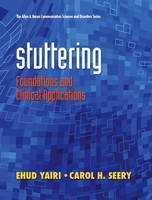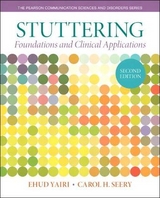
Stuttering
Pearson (Verlag)
978-0-13-157310-9 (ISBN)
- Titel erscheint in neuer Auflage
- Artikel merken
The first edition of Stuttering: Foundations and Clinical Applications contains the most comprehensive and complete presentation of the science and treatment of stuttering available in a single text. Authors Ehud Yairi and Carol H. Seery present a wealth of knowledge on how stuttering is defined, how stuttering is explained, and how stuttering is treated in one strategically organized and comprehensive volume.
This inclusive and sweeping text offers students up-to-date clinical and scientific ideas communicated with the aide of multiple perspectives and engaging activities. Stuttering: Foundations and Clinical Applicationsis unique in its coverage of the stuttering population, its in-depth look at stuttering therapy at various ages, and its original approach that invites students to offer critical appraisals of differing theoretical viewpoints.
Ehud Yairi, Ph.D., CCC-SLP, is an internationally recognized expert on stuttering who teaches at the University of Illinois at Urbana-Champaign and Tel Aviv University. He is the recipient of the Honors of the Association from the American Speech-Language-Hearing Association, the Researcher Award of Distinction from the International Fluency Association, and the Malcolm Fraser Award for excellence in the field of stuttering from the Stuttering Foundation of America. He is the coauthor of Early Childhood Stuttering (Pro-Ed, 2004) as well as numerous articles on the subject. Carol Hubbard Seery, Ph.D., CCC-SLP, currently a professor at the University of Wisconsin-Milwaukee, Seery has engaged in teaching, research, and clinical service in schools and other settings related to stuttering for over twenty years. A board certified specialist in fluency disorders, she has authored and co-authored multiple articles in scientific journals, has presented on stuttering in many forums, and serves on the editorial board for the Journal of Communication Disorders.
Part I Nature of Stuttering
Chapter 1. What Is Stuttering?
Chapter 2. Who and How Many Stutter?
Chapter 3. When and How Does Stuttering Begin? How Does it Develop?
Chapter 4. Where Does It End? Advanced Characteristics, Rules, and Phenomena
Part II Explanations of Stuttering
Chapter 5. Why Do People Stutter? Evaluating Theories and Models
Chapter 6. Is Stuttering Psychological? Psychoemotional, Psychobehavioral, and Psycholinguistic Theories
Chapter 7. Is Stuttering Biological? Neurological, Motor, and Genetic Perspectives
Part III Clinical Management of Stuttering
Chapter 8. Stuttering Therapy: Issues, Directions, Research, Ethics
Chapter 9. Assessment of Adults and School-Age Children
Chapter 10. Adult Therapy: Focus on Emotional Reactions
Chapter 11. Therapy for Adults: Focus on Stuttering and Fluency
Chapter 12. Therapy for School-Age Children
Chapter 13. Assessment of Stuttering in Early Childhood
Chapter 14. Treatment of Preschool-Age Children Who Stutter
Chapter 15. Other Fluency Disorders and Multicultural/Bilingual Issues
| Erscheint lt. Verlag | 12.7.2010 |
|---|---|
| Sprache | englisch |
| Maße | 187 x 232 mm |
| Gewicht | 1023 g |
| Themenwelt | Medizin / Pharmazie ► Gesundheitsfachberufe ► Logopädie |
| ISBN-10 | 0-13-157310-1 / 0131573101 |
| ISBN-13 | 978-0-13-157310-9 / 9780131573109 |
| Zustand | Neuware |
| Haben Sie eine Frage zum Produkt? |
aus dem Bereich



